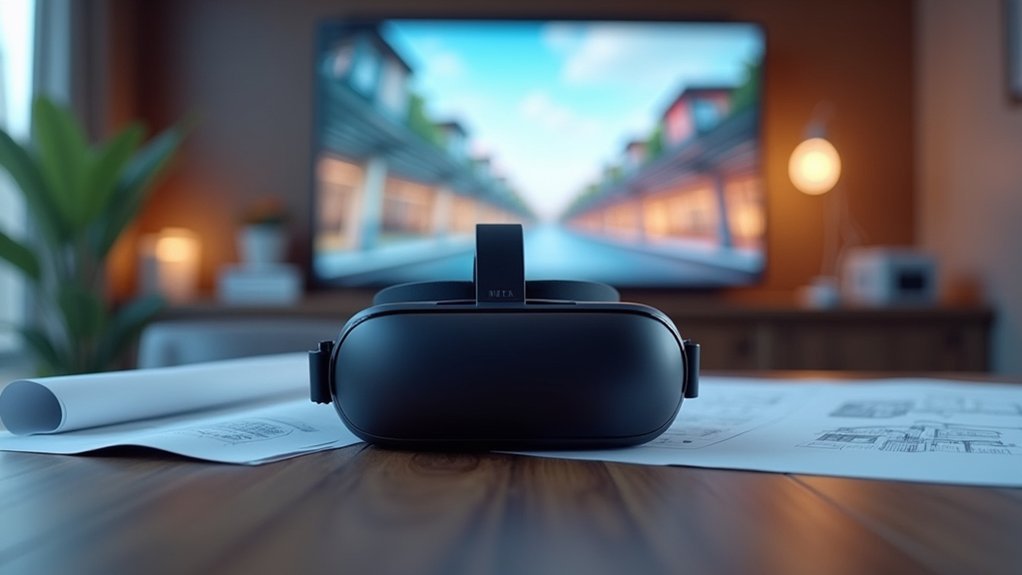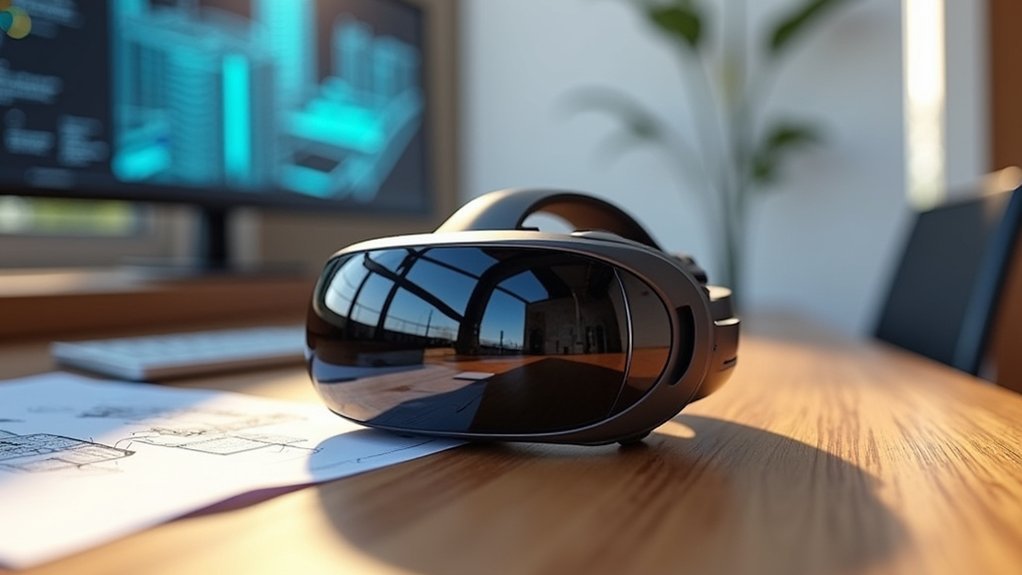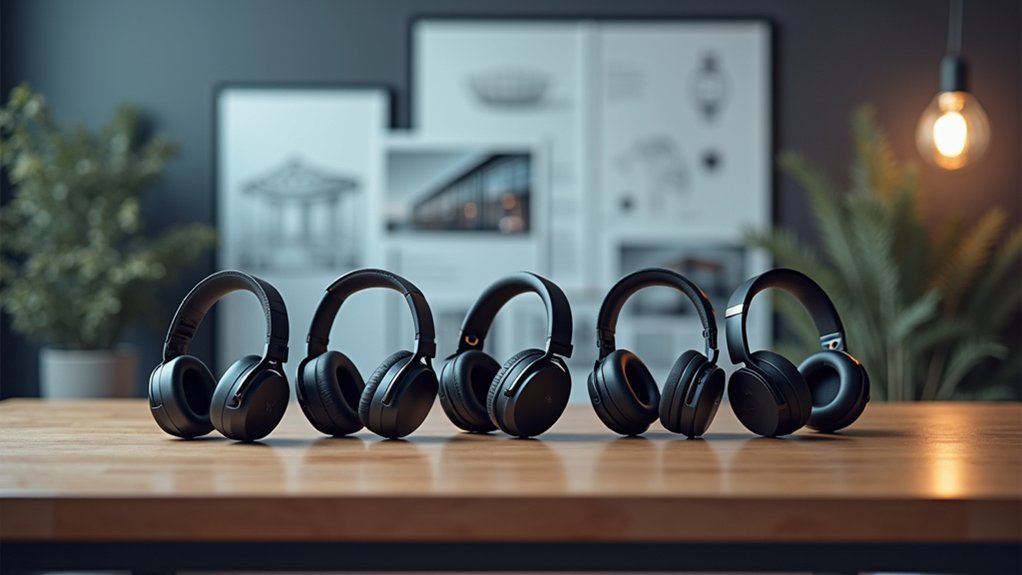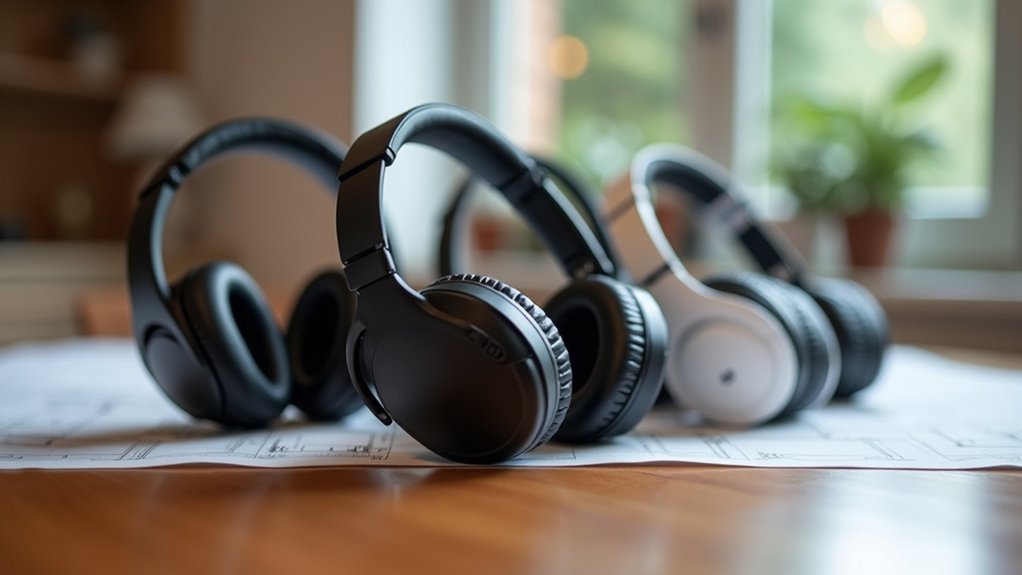For architectural visualization, you’ll find the Meta Quest 3 offers excellent mixed reality with color passthrough technology, while the HTC Vive Pro 2 delivers stunning 5K resolution for detailed client walkthroughs. The Varjo XR-3 provides human-eye resolution with 70 PPD clarity, and the Valve Index features a wide 130-degree field of view for spatial understanding. Your budget will influence your choice, with options ranging from affordable wireless solutions to high-end systems over $5,000. Explore these options to transform your client presentations.
Meta Quest 3: Mixed Reality for Architectural Presentations

While traditional VR headsets have served architects well, the Meta Quest 3 revolutionizes architectural visualization through its groundbreaking mixed reality capabilities.
The headset’s color passthrough technology lets you seamlessly blend virtual designs with real environments, transforming how you present concepts to clients.
With the Snapdragon XR2 Gen 2 processor and 2064 x 2208 resolution per eye, you’ll experience smoother rendering of complex architectural models with unprecedented detail.
The Quest 3’s 40% slimmer design and improved ergonomics make it comfortable for extended design sessions. Applications like Fluid allow for customizable screen placements that enhance your workspace flexibility.
You’ll appreciate the Arkio integration for architectural design and the intuitive collaboration features that connect remote teams in shared virtual spaces.
On-site visualization becomes effortless as you overlay digital elements onto real-world settings with precision.
HTC Vive Pro 2: Immersive Client Walkthroughs
When you’re guiding clients through detailed architectural plans, the HTC Vive Pro 2 stands out as an exceptional visualization tool that transforms abstract concepts into navigable spaces.
Its 5K resolution display (4896 x 2448) reveals intricate design details that might otherwise be missed in traditional presentations.
The 120° field of view and 120Hz refresh rate create a seamless experience that mirrors natural vision, allowing clients to perceive spatial relationships accurately.
You’ll appreciate how the laser-accurate tracking captures every movement as clients explore virtual environments. The adjustable interpupillary distance feature helps minimize eye fatigue during extended client presentations.
The Vive Pro 2 integrates smoothly with architectural software like Twinmotion, enabling real-time rendering and on-the-fly modifications during client meetings.
This reduces the need for physical models while enhancing client engagement and ultimately improving design feedback.
Varjo XR-3: High-Resolution Design Visualization

Because architects require uncompromising visual clarity when evaluating complex details, the Varjo XR-3 represents a paradigm shift in design visualization technology.
Its Full Frame Bionic Display delivers human-eye resolution with 70 PPD in the focus area and impressive color accuracy covering 99% sRGB.
What sets the XR-3 apart is its mixed reality capabilities, combining dual 12-megapixel pass-through cameras with LiDAR sensing for precise depth awareness up to 5 meters. This allows you to seamlessly blend physical models with virtual elements during client presentations. The device offers ultra-low latency of 20 ms for seamless virtual visualizations in architectural designs.
The headset’s 115° field of view, 90Hz refresh rate, and automatic IPD adjustment guarantee comfort during extended design sessions.
Extended design sessions become effortlessly immersive with 115° views, 90Hz responsiveness, and self-adjusting optics for maximum comfort.
With its balanced weight distribution and versatile tracking options, you’ll experience architectural visualizations with unprecedented realism and precision.
Valve Index: Premium VR Experience for Spatial Design
Three key features make the Valve Index a standout choice for architectural professionals seeking immersive spatial design capabilities.
First, its dual 1440×1600 RGB LCD displays with 601 PPI deliver exceptional visual clarity essential for detailed architectural renderings.
Second, the wide 130-degree field of view allows you to examine spatial relationships more naturally than competing headsets.
The Index’s refresh rate options (up to 144Hz) provide smoother visualization experiences when walking through virtual buildings. The headset’s integrated off-ear speakers create a more immersive audio environment when presenting designs to clients.
You’ll appreciate the precise tracking from Lighthouse 2.0 technology when examining detailed models.
While the $999 price point positions it as a premium option, its durability and upgrade potential offer long-term value for architectural firms.
The adjustable IPD guarantees comfort during extended design sessions, making this investment particularly worthwhile for spatial visualization professionals.
Comparing Cost vs. Performance for Architectural Firms

While the Valve Index offers premium capabilities for spatial design, determining the right headset for your architectural firm ultimately hinges on balancing cost against performance needs. Your budget will greatly impact available options, with investments ranging from a few hundred to over $5,000 for complete setups.
Finding the right VR headset for architects means balancing premium features against real-world budget constraints.
For firms prioritizing ultra-detailed visualizations, high-end solutions like the Varjo XR-4 deliver 4K resolution per eye and superior mixed reality capabilities—essential for client presentations and complex projects.
Meanwhile, the Meta Quest series provides a cost-effective entry point for smaller practices or simpler modeling needs.
Consider your workflow requirements: Will you need seamless integration with Revit or Unreal Engine? Is eye tracking necessary for your detailed model inspections? Wireless headsets provide superior mobility for presentations when guiding clients through virtual spaces before construction begins.
These performance factors should guide your investment decision beyond initial hardware costs.
Frequently Asked Questions
Can Architectural Headsets Be Shared Among Multiple Team Members?
Yes, you can share architectural VR headsets among team members through multi-user support, casting technology, and shared viewing methods like VR domes. Collaborative software allows real-time interaction in the same virtual environment.
How Does Eye Strain Compare Across Different Vr/Ar Headsets?
Eye strain varies across headsets based on weight, resolution, refresh rate, and FOV. You’ll experience less strain with lighter devices offering IPD adjustment, higher refresh rates, and eye care features like blue light filtering.
What Maintenance Costs Should Firms Expect for These Headsets?
You’ll face ongoing costs for hardware replacements ($100-300 annually), software subscriptions, cleaning supplies, and calibration services. Budget 15-20% of the headset’s purchase price yearly for maintenance to guarantee peak performance.
Do Headsets Support Real-Time Collaboration Between Remote Team Members?
Yes, today’s VR headsets support real-time collaboration between remote team members. You’ll enjoy features like multi-user sessions, hand tracking, and cross-platform compatibility that let you design together in shared virtual environments instantly.
Are Headset Software Subscriptions Required for Architectural Visualization Tools?
No, you don’t need headset software subscriptions for most architectural visualization tools. They function independently, though VR integration may require additional software. Headsets enhance presentation but aren’t mandatory for the core visualization functionality.
In Summary
You’ll find the perfect headset depends on your specific needs. If you’re presenting to clients, the Meta Quest 3 offers portability while the Varjo XR-3 delivers unmatched clarity. For immersive design work, the Valve Index or HTC Vive Pro 2 excel. Consider your budget, technical requirements, and how you’ll use VR/AR in your workflow before investing in this transformative technology.





Leave a Reply